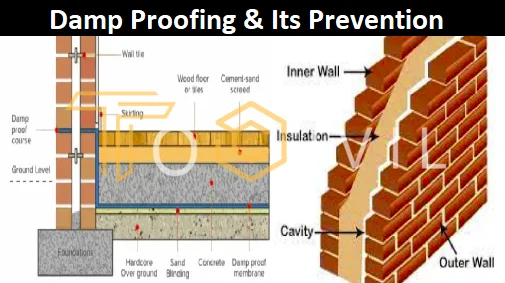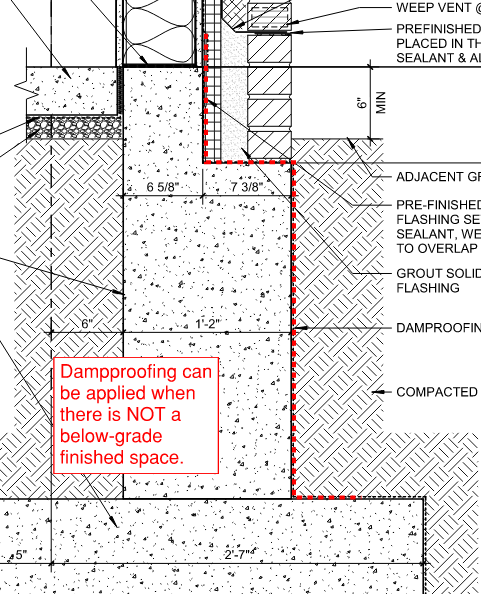Is your property at risk? Use this guide from damp specialist newcastle to find out
Checking Out the Different Techniques and Solutions for Effective Damp Proofing
Dampness in buildings poses substantial difficulties to both architectural honesty and indoor air quality. Various techniques and solutions have arised to combat this pervasive issue. From typical damp-proof membranes to ingenious chemical treatments, each method supplies unique advantages. Comprehending these choices is essential for efficient wetness control. However, selecting the right option relies on details building conditions and needs, prompting further expedition right into one of the most reliable wet proofing strategies available.
Understanding the Reasons For Dampness
Moisture can arise from numerous resources, understanding these reasons is important for reliable removal. Typically, wetness originates from 3 main resources: increasing wet, permeating wet, and condensation. Increasing wet happens when groundwater takes a trip upwards via porous products, such as block or rock, often as a result of a lack of an efficient barrier (damp proofing newcastle). Permeating damp is normally triggered by outside factors, including roof leaks, defective seamless gutters, or harmed walls, enabling water to infiltrate a property. Condensation, on the various other hand, results from excess moisture airborne, usually exacerbated by poor air flow and temperature distinctions, leading to water droplets basing on surfaces. Determining these underlying issues is vital, as each kind of wetness calls for a tailored method for remediation. Correct assessment aids in determining the most reliable solutions, ultimately protecting the structural stability of a structure and improving indoor air top quality
Conventional Damp-Proof Membranes

Chemical Damp-Proofing Solutions
Chemical damp-proofing solutions use an innovative approach to stop moisture breach in structures. These methods generally involve the application of liquid chemicals that permeate masonry and form an obstacle versus rising damp. Frequently used chemicals include silanes, siloxanes, and other water-repellent agents that react with surface products to create a hydrophobic layer.The application procedure generally calls for exploration openings right into the wall surfaces, infusing the chemical option, and allowing it to treat. This technique is especially useful for older frameworks where typical damp-proof membrane layers might be unwise. In addition, chemical damp-proofing can be much less disruptive and extra economical than extensive restoration projects.While reliable, these services depend on correct application and ecological conditions for peak efficiency. Normal maintenance and tracking are important to guarantee the longevity of the damp-proofing therapy. Generally, chemical damp-proofing stands for a flexible alternative for safeguarding buildings versus moisture-related damage
Cavity Wall Building And Construction Strategies
Cavity wall surface building and construction techniques provide numerous advantages, specifically in dampness control and power effectiveness. By incorporating an air void between two layers of masonry, these walls successfully mitigate water ingress while enhancing insulation. This mix not only secures structures from moisture yet additionally adds to lowered power intake.
Advantages of Tooth Cavity Walls
When taking into consideration efficient damp proofing techniques, the advantages of tooth cavity walls stand out plainly. Cavity walls consist of 2 different layers, producing an air void that properly minimizes wetness penetration. This design lessens the threat of dampness, as the external wall surface works as an obstacle against rain and water access. Furthermore, cavity wall surfaces boost thermal insulation, which adds to energy efficiency by minimizing warm loss. They additionally supply audio insulation, helping to produce a quieter interior atmosphere. The air void permits for ventilation, which aids in wetness control and minimizes the likelihood of mold growth. These advantages not just enhance the general convenience of a structure but likewise add to its durability and architectural integrity.
Wetness Control Approaches
Efficient moisture control strategies are crucial in cavity wall construction to ensure long-lasting protection versus wetness. One primary method includes the consolidation of weep openings, which help with water drain from the tooth cavity, preventing accumulation. Additionally, the use of breathable membranes can help handle dampness levels while allowing caught vapor to get away. Proper positioning of insulation is also vital, as it needs to not obstruct drain paths. Moreover, ensuring that the outer leaves of the tooth cavity wall surface are built with water-resistant materials improves total durability. Regular maintenance checks are vital to determine any kind of clogs or damages early, safeguarding the framework's stability. Inevitably, a mix of these strategies develops a robust defense versus wetness breach in cavity wall surfaces.
Insulation and Energy Effectiveness
Insulation plays a vital function in improving power performance within cavity wall construction. By integrating shielding products, these wall surfaces produce a thermal barrier that lessens warm loss and decreases energy consumption. Reliable insulation not just assists preserve a stable interior temperature level yet additionally alleviates the danger of dampness, as it prevents condensation within the wall surface tooth cavity. Different techniques, such as the usage of inflexible foam boards or mineral wool, can be used to achieve perfect insulation performance. In addition, appropriate installation is important to assure that voids and voids are lessened, which can otherwise endanger power efficiency. Inevitably, a well-insulated tooth cavity wall contributes significantly to total sustainability and reduces heating & cooling expenses for property owners.
Outside Damp Proofing Techniques
External damp proofing approaches are crucial for shielding frameworks from moisture infiltration. 2 efficient techniques consist of the application of waterproof membrane layers and the installation of French drains. These options assist minimize water build-up and maintain the integrity of buildings.
Waterproof Membrane Layer Application
While various methods exist for preventing wetness access, the application of waterproof membranes continues to be a highly effective outside wet proofing strategy. These membranes are usually made from materials such as polyethylene, rubber, or customized asphalt, supplying a robust obstacle versus water infiltration. The setup process involves applying the membrane to the exterior surface areas of structures or wall surfaces, ensuring complete protection to stop leaks. Appropriate bond and sealing at joints are important to making best use of effectiveness. Water-proof membrane layers can be used in numerous forms, including liquid finishes and sheet membrane layers, enabling flexibility based on the specific requirements of the structure. This method not only safeguards buildings from dampness but additionally boosts their long life and structural integrity.
French Drain Installment
One reliable technique for managing groundwater and avoiding wetness accumulation around a building's structure is the setup of a French drain. This water drainage system includes a trench filled up with gravel and a perforated pipeline that redirects surface water away from the foundation. Appropriate installation requires mindful preparation, making certain that the drainpipe slopes away from the structure to help with ideal water circulation. Furthermore, the area of the drain is vital; it needs to be positioned in areas vulnerable to pooling or excess moisture. Normal upkeep, including clearing up particles from the gravel and making certain the pipe remains unblocked, is important for long-term efficiency. Ultimately, a well-installed French drainpipe can greatly minimize the risk of water-related concerns in foundations and cellars.
Inside Waterproofing Techniques
Inside waterproofing methods are important for protecting a structure's inside from wetness seepage and potential water damage. These approaches typically involve the application of customized products and methods designed to create a moisture obstacle within the framework. One common method is using water resistant coverings or sealers on walls and floors, which protect against moisture from passing through surfaces.Additionally, installing indoor drainage systems, such as sump pumps, can successfully take care of water accumulation in basements and crawl areas. One more approach involves the use of vapor barriers, which are mounted to hinder moisture movement from the ground into living spaces.Moreover, addressing any type of fractures or voids in wall surfaces or foundations with suitable sealants ensures a detailed protection versus water breach. By applying these interior waterproofing techniques, homeowner can significantly decrease the threat of mold and mildew growth, architectural damages, and various other moisture-related concerns. Correct implementation of these strategies is essential for long-term protection and building honesty.
Regular Upkeep and Examination Practices
Normal upkeep and assessment methods are important for guaranteeing the lasting performance of moist proofing services in any building. Regular checks allow homeowner to identify early indicators of wetness intrusion, such as peeling off paint, mold development, and mildewy smells. These signs can signal underlying issues that call for prompt attention.Inspections must be carried out a minimum of yearly, focusing on at risk areas like basements, creep spaces, and outside walls. Throughout these assessments, property proprietors should check out sealants, drainage systems, and air flow to confirm they function correctly.Additionally, keeping seamless gutters and downspouts is vital, as clogged systems can bring about water build-up near the foundation. Applying a regular maintenance schedule, in addition to timely repairs, can substantially prolong the lifespan of wet proofing steps and protect the architectural integrity of the building. Proactive actions eventually add to the general wellness and security of the living setting.
Regularly Asked Questions
Exactly How Lengthy Does Damp Proofing Usually Last?
The period of damp proofing efficiency differs, commonly lasting between 20 to 50 years. Aspects such as application top quality, ecological conditions, and maintenance techniques greatly affect the long life of the damp proofing treatment.

Can I Damp Proof My Home Myself?
The private contemplated the feasibility of DIY damp proofing. With proper research and the right products, it is possible. Nonetheless, they likewise recognized the significance of professional assistance to ensure resilient performance and prevent future problems.
What Are the Indicators of Inadequate Damp Proofing?
Indications of inadequate damp proofing include consistent stuffy odors, visible mold growth, peeling off paint, wet patches on walls, and wood degeneration - damp removal newcastle. House owners should attend to these concerns promptly to stop additional damages and wellness problems
Does Damp Proofing Affect Indoor Air Top Quality?

Just How Much Does Specialist Damp Proofing Cost?
Expert wet proofing costs vary substantially, generally varying from $1,000 to $5,000 relying on the home's dimension, the extent of the damp problem, and selected approaches. Each scenario requires a tailored evaluation for precise prices. Generally, wetness originates from three main sources: increasing moist, passing through wet, and condensation. When considering effective moist proofing approaches, the advantages of dental caries walls stand out plainly. External moist proofing approaches are necessary for protecting frameworks from dampness infiltration. While numerous methods more info exist for stopping moisture ingress, the application of water resistant membrane layers remains an extremely reliable exterior damp proofing method. Indicators of inefficient wet proofing consist of persistent mildewy smells, visible mold development, peeling off paint, wet patches on walls, and wood degeneration.